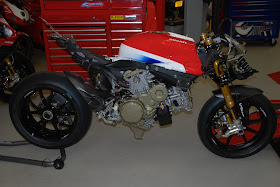The bike still needed the fuelling set up, suspension dialling in for me and tyres.
The first thing to do was tuning. This gave me some real problems: firstly, the leads (laptop to plug) and software are specific to just a few bikes - the 998RS and 749R amongst them and the looms and plugs aren't always he same (I have spare looms for the bike, some having a 13 pin plug like this, some having fewer pins). It's still possible to have the lead made and I have been offered leads and software, but at Ducati Corse prices. So I needed to find someone with the leads and a dyno. There aren't many people in England with the correct kit and there's only one with the kit, a dyno and experience of tuning the race ECU - John Hackett.
After a lot of discussion and many delays caused by holidays (mine) and racing (Johns), I finally got the bike up to JHP. I'd never been up to JHP, but I was really impressed. The showroom has the usual Ducatis mixed in with race bikes from the nineties up. Customers bikes are kept in the workshop, which is kept spotlessly clean. There's an engine-building clean room next to Johns office (which has it's own coffee machine, dispensing very good coffee!), an assembly area for bikes - customers bikes are built in the same area as the race bikes - and what I would describe as an engineering shop where special parts can be fabricated. Next to the engineering shop is a separate area where a group of Desmos hang out together.
Now, bearing in mind that John and I have never met and I've only ever bought a pair of belts from JHP, I was made to feel very welcome by John and all the staff. John and Rick (his son) showed me around the workshop and showroom and we discussed what was needed for the bike and what was entailed in setting up this ECU.
The race motor has two timing pickups - the additional parts (1, 2, 4, 5, and 6) can be seen below:
and the timing cover is unique to the production bikes in having provision for the pickup lead (although it needs to be drilled out). This second pickup is required because both cylinders are mapped individually - essentially, the ECU is looking at two single-cylinder motors.
To map this ecu, two software programs are used: one that runs in Windows and allows the dyno operator to create the map and another that runs in DOS to send the map to the ECU. John spent a day running the bike, examining the data, creating new maps for both cylinders, storing the maps in the ECU and repeating the process to see how the new map was working.
All this took time and had to be done around two BSB rounds whereJHP were running a Panigale with Polita on board, so I went cycling in Italy with my buddies : )
When I got back, I was able to collect the bike and get some pictures of the very special bikes JP builds.
This is a Pierobon framed special built by JHP. These get down to 110kg and put out up to 140bhp. An incredible bike.
 |  |  |
This is Stuart Eastons 749R from BSB. It was bought by a customer of JHPs and is maintained by them. Note the ECU upgrade - this and other mods demonstrate the common development.
 |  |
JHP / Alex Politas Panigale
As I said earlier, John and the team were busy getting the bikes ready for BSB and I was able to walk around them. The specification is similar to the MotoRapido bikes, but it's still good to see them again : )
Alex Polita is a test rider with a Ducati Corse contract. He has a lot of time on the Panigale. I expect him to be doing good things next year.
 In the interest of saving money, BSB rules mandate that a 'series' ECU is used and that the team can only bring one bike per rider to a race meeting. What this means in practice is that a team can't make use of the factory's development using the bikes ECU, or an ECU from another race series such as WSS or WSB and must tune the bikes to run with the series ECU. Stock pistons mean that instead of putting 2 pistons, costing maybe £800 into a bike to raise compression, teams must manufacture other parts, costing thousands. The 'one bike per rider' rule means that a team must either ship boxes of parts, or rolling chassis to each meeting.
In the interest of saving money, BSB rules mandate that a 'series' ECU is used and that the team can only bring one bike per rider to a race meeting. What this means in practice is that a team can't make use of the factory's development using the bikes ECU, or an ECU from another race series such as WSS or WSB and must tune the bikes to run with the series ECU. Stock pistons mean that instead of putting 2 pistons, costing maybe £800 into a bike to raise compression, teams must manufacture other parts, costing thousands. The 'one bike per rider' rule means that a team must either ship boxes of parts, or rolling chassis to each meeting.
I'm sure it makes good sense somewhere, but if the goal is to reduce costs, I cant see how it's working.
 | ||
 |
 |
 |
Strapped to the expansion bottle is the race transponder.
Minimalist!
...finally, more Desmo loveliness!
Falcon dash - same as used on the 749R and 999 race bikes
Dry break brake lines!
One careful lady owner

















No comments:
Post a Comment